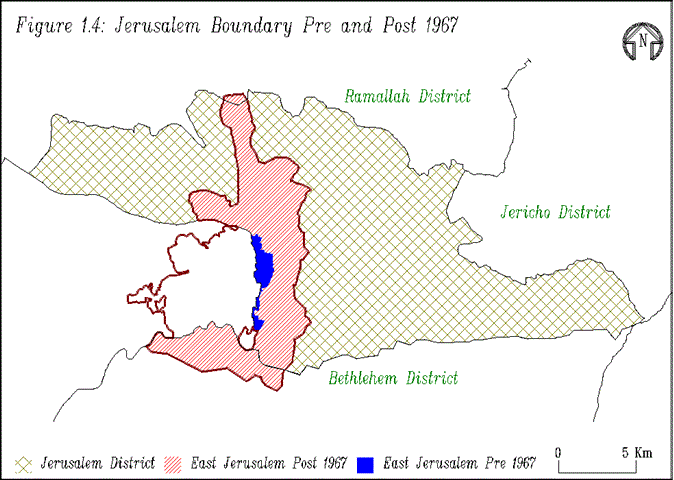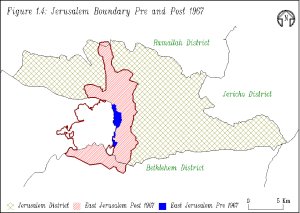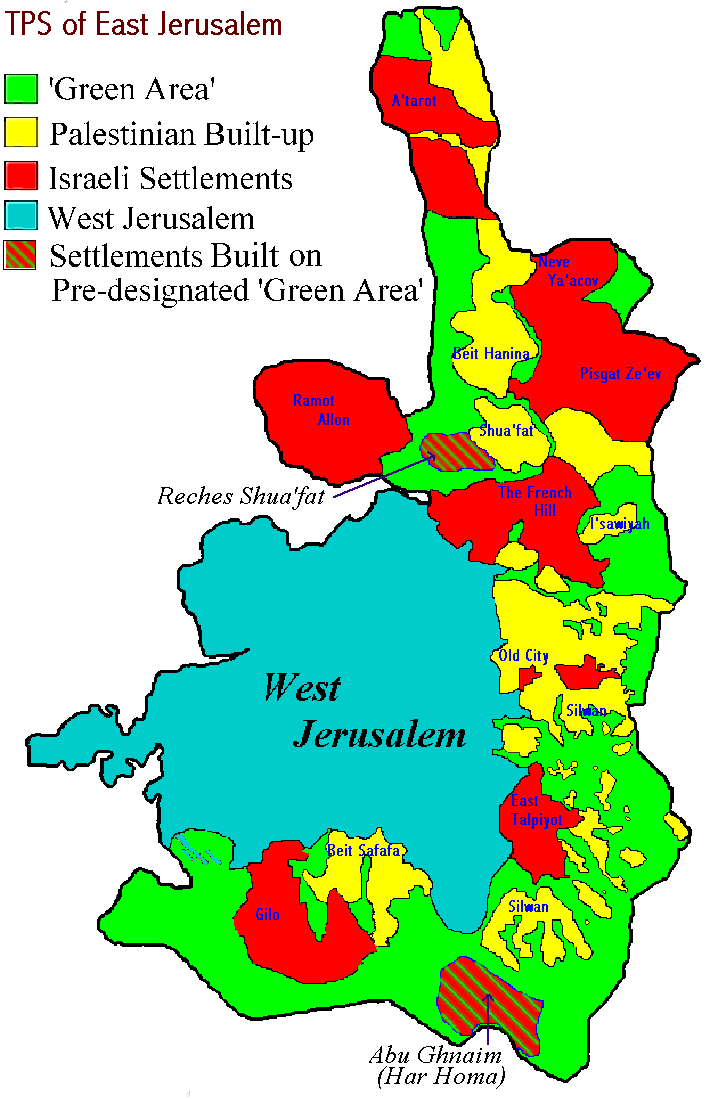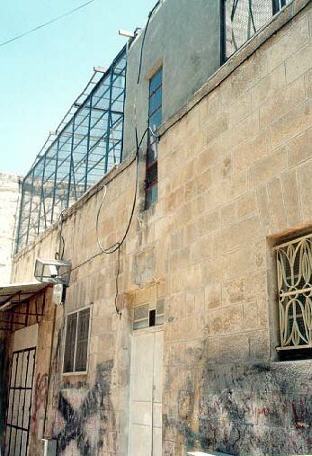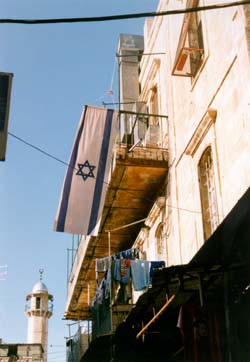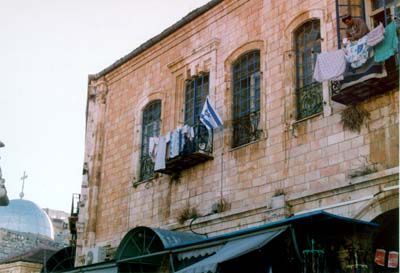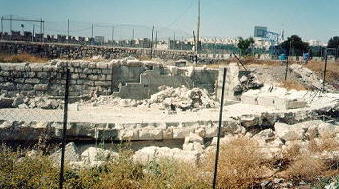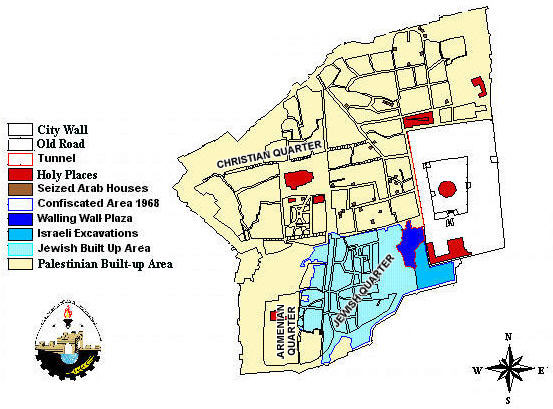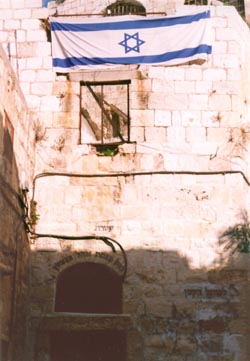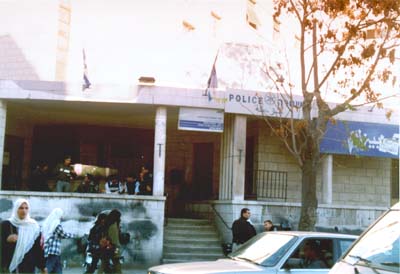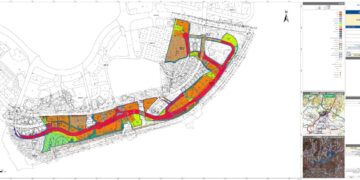Introduction
The many proposals put forward over the years for the solution to the Arab-Israeli conflict -with the Palestine question at its core- have all recognized the need to give special treatment to Jerusalem. This is mainly because of its unique character as the historic site of the Holy Places of the three monotheistic religions, as well as its symbolic nature and its significance for the identity of the peoples of the region. Numerous statements, documents, position papers and resolutions concerning the city and its special status have been made or written, but the question of Jerusalem is still nonetheless an unresolved issue and a source of conflict between the two peoples concerned.
Jerusalem today consists of two cities: occupied East Jerusalem and West Jerusalem. By signing the Declaration of Principles on Interim Self-Government Arrangements (DoP) on September 1993, Israel and the PLO have made a commitment that “the permanent status negotiations will commence as soon as possible, but not later than the beginning of the third year of the interim period”… and will “cover remaining issues, including: Jerusalem”. Despite this and not withstanding its reiterated commitment to the DoP, the Israeli government's position is that Jerusalem will remain undivided under Israeli control, thus implying that there is nothing left to negotiate.
Jerusalem was an Arab city run by a Palestinian Muslim mayor from the seventh century to May 1948. However, from May 1948 to the present, the city of Jerusalem has endured a process of Judaization brought about by the dispossession and uprooting of its indigenous Muslim and Christian Palestinian population and then by their replacement with Jewish immigrants. This displacement of Palestinians from the Holy City has been achieved largelly, in two stages. The first stage occurred in May 1948 when the Zionist forces occupied all of what has come to be known as West Jerusalem, evicted by force its approximately 60,000 Palestinian inhabitants and physically took over their lands, villages and homes.
The second stage took place after the Israeli occupation of East Jerusalem during the 1967 war. Israel annexed East Jerusalem and began a process of colonization by confiscating private Palestinian property and then proceeding to build on such lands (figure 1). Today Israel is in complete control of the city, yet most of the property and real estate still legally belongs to the indigenous Palestinians who have been living continuously in Jerusalem for centuries. Israel’s intensive development program post-1967 has involved the construction of housing and associated infrastructure in the unilaterally annexed and expanded territory of occupied East Jerusalem. In 1967, Israel expanded the borders of East Jerusalem from 6.5 to over 70 km² to include lands from many West Bank villages while excluding populated Palestinian areas ( Today Israel is in complete control of the city, yet most of the property and real estate still legally belongs to the indigenous Palestinians who have been living continuously in Jerusalem for centuries. Israel’s intensive development program post-1967 has involved the construction of housing and associated infrastructure in the unilaterally annexed and expanded territory of occupied East Jerusalem. In 1967, Israel expanded the borders of East Jerusalem from 6.5 to over 70 km² to include lands from many West Bank villages while excluding populated Palestinian areas (figure 2).
figure 1: Jerusalem Boundary Pre and Post 1967
figure 2: Borders of East Jerusalem as defined by the Israeli Government
The Old City
The Old City is one of the oldest continuously inhabited cities in the world; archeologists have estimated its age at approximately 6,000 years. The Old City, situated in the heart of East Jerusalem, was founded as early as 4000BC and captured by Israel in the 1967 War. It is one of the most holy sites for the three monotheistic religions. The first impression you get when entering the city is its Middle Eastern appearance and architecture, with its narrow crowded streets and unique bazaars. The present-day massive stone walls of the Old City were built c. 1537 under the Turkish Sultan Suleiman the Magnificent. The location of its seven gates (Herod’s, Damascus, and New gates in the north; Jaffa Gate in the west; Zion and Dung gates in the south; and St. Stephen’s Gate in the east) is thought to be identical to that of the gates of antiquity.
Inside the walls of the Old City, four quarters are distinguished: the Christian Quarter to the northwest grouped around the Church of the Holy Sepulchre; the Armenian Quarter to the southwest; the Muslim Quarter to the center and northeast; and the Jewish Quarter to the southeast.
Annexation and Colonization of East Jerusalem
Shortly after the 1967 occupation of East Jerusalem, the Jewish state began a series of measures intended not only to maintain Jewish control over the city and its Palestinian population, but also to change its demographic character, its geopolitical boundaries, and its legal and physical status. This has been accomplished by moving Jews to the occupied part of Jerusalem and building exclusively Jewish residential and industrial colonies on confiscated private Palestinian property (figure 3). What follows is a brief account of the measures and policies adopted by the Israeli government in East Jerusalem since June 1967.). What follows is a brief account of the measures and policies adopted by the Israeli government in East Jerusalem since June 1967.
figure 3: Jewish residential colony in the Old City
The first measure of the state of Israel was to dismiss and disband the elected Palestinian Municipality of East Jerusalem that had been functioning since 1948. The elected Palestinian mayor, Rohi El-Khatib, was subsequently deported to Jordan for refusing to accept the dissolution of his municipality.
The Old City of East Jerusalem
Shortly after fighting ended on 10 June 1967, Jewish bulldozers destroyed over 135 homes in the Magharbeh (Moroccan) neighborhood (directly in front of the Western Wall and the Dome of the Rock) (figure 4) to make way for a plaza. The Palestinian inhabitants were forced to leave in several hours, and their houses were dynamited. In the wake of this destruction, 650 Palestinians were left homeless. Within two days, the entire neighborhood had been demolished. Between 10-11 June 1967, the Sharaf neighborhood was eradicated, as well. Two mosques and 700 buildings (including 1,840 apartments which housed approximately 6,000 Palestinians and 437 shops which supported 700 laborers) were demolished. A collection of houses and businesses were constructed on that spot, which was re-named the Jewish Quarter () to make way for a plaza. The Palestinian inhabitants were forced to leave in several hours, and their houses were dynamited. In the wake of this destruction, 650 Palestinians were left homeless. Within two days, the entire neighborhood had been demolished. Between 10-11 June 1967, the Sharaf neighborhood was eradicated, as well. Two mosques and 700 buildings (including 1,840 apartments which housed approximately 6,000 Palestinians and 437 shops which supported 700 laborers) were demolished. A collection of houses and businesses were constructed on that spot, which was re-named the Jewish Quarter (figure 5). On 22 June 1967, the Jewish state formally annexed occupied East Jerusalem by extending over the city the law, jurisdiction and administration of the State of Israel despite strong opposition from Palestinians and the international community who declared the annexation illegal.
Regardless of the many international resolutions condemning this annexation, particularly U.N. Resolutions 252 of 21 May 1968, 267 of 3 July 1969, and previous U.N.General Assembly Resolutions 2253 (ES-V) and 2254 (ES-V) of 4 and 14 July 1967, Israel has continued its policies and has, moreover, proceeded to Judaize the city. On 28 June 1967, the Israeli government confiscated 116 dunums in the Old City.
figure 4: Photo showing the sacred place of Islam’s third holiest shrine, the Dome of the Rock
figure 5: Part of the Jewish Quarter
As a result of these measures, the Jewish Quarter of the Old City is today four times its pre-1948 size. On 26 June 1968, an Australian Jewish tourist named Michael Dennis Rohan set fire to the Al-Aqsa Mosque and caused considerable damage. Meanwhile, various Jewish extremists intensified their activities by seizing buildings and residential units, especially in the Muslim Quarter, Al-Wad Street and the southern side of Al-Silsilah Street which has been extended to Aqaba Al-Khalidiyah, Aqaba As-Siraya and Sa’adiya neighborhoods, as well as other places. From 1967 to the present, fraudulent means such as contracts signed illegally by secondary leaseholders have been used by Israeli colonists to take over 40 buildings inside the Muslim Quarter (figure 6).
figure 6: One of the Jewish houses in the Muslim Quarter
As of today, not a single new Palestinian neighborhood has been planned in East Jerusalem while more than seventeen Jewish colonies have been built and several more planned. Such policies have changed the demography of the city from just a few hundred Jews in 1967 to over 160,000 today. The forcible closure of the city imposed since March 1993 has had a dramatic impact on the lives of all Palestinians; West Bank and Gaza Palestinians are denied free access to East Jerusalem.
On 15 December 1987, the present Minister of Infrastructure Ariel Sharon occupied a Palestinian owned apartment in the Muslim Quarter of the Old City (figure 7). He visits the apartment from time to time.
figure 7: Apartment occupied by Ariel Sharon in the Muslim Quarter
With the beginning of the Intifada, the settlement movement made the Old City its utmost priority. By collecting funds from donors, Ariel Sharon stepped up repair on his home in the heart of Aqaba Khalidiya neighborhood. He initiated the establishment of a special fund for this objective. For example, in one evening in New York, he was able to raise nearly $20 million to support the Jewish colonies in Jerusalem.
In the afternoon of 11 April 1990, 150 settlers, many of them armed, forcibly occupied St. John’s Hospice in the heart of the Christian Quarter of the Old City, a 3,000-square meter property of the Greek Orthodox Patriarchate.
It was acquired for Jewish settlers from its Armenian tenant. The legality of the transaction is still under adjudication in the courts. Even after protests from Palestinians and the local religious hierarchy, as well as appeals to the Israeli courts, Jewish residents still occupy the building (figure 8).).
figure 8: The Occupied St. John’s Hospice in the Christian Quarter
On 27April 1990, the Church of the Holy Sepulchre locked its doors for first time in 800 years, and all other Christian shrines in the country also closed in protest over the presence of Jewish settlers in St. John’s Hospice in Jerusalem. In an expression of Palestinian religious solidarity, the Higher Islamic Council decided to close the doors of Al-Haram al-Sharif (Al-Aqsa Mosque & the Dome of the Rock) compound to foreign visitors and tourists all day Friday 27 April 1990.
Israel has tightened Palestinian residential expansion in the Old City by severely limiting building and renovation licenses, seizing Palestinian houses, and allowing Israeli Jews to settle in the houses. Restrictions are imposed by the Jerusalem Municipality on construction even when building permits are granted. These restrictions are expressed in the following building codes (Kaminker, 1995):
-
Palestinians are only allowed to built on 15%, 25%, or 50% of the land plot as floor space, depending on the zoning and area of construction. In contrast, Israeli Jews building in East Jerusalem settlements are allowed to build with a floor space as much as 200% of the land.
-
Palestinian buildings in East Jerusalem are confined to one or two stories, whereas Israeli settlements can have buildings up to eight stories.
-
Palestinians owning land larger than 0.1 hectare in size are required to divide the land into parcels of a maximum of 0.1 hectare in order to be granted building permits. This law is strictly applied even when the land is only few square meters larger than 0.1 hectares.
In addition, the Israeli government imposes high taxes on Palestinians, and revokes Jerusalemites' identity cards. The Israeli Ministry of Interior withdrew approximately 4,000 Jerusalemites' IDs during the past 30 years of the Israeli occupation of East Jerusalem (Al-Quds newspaper, 9 August 1997, Issue no. 10041).
The Case of Identity Card Loss / Withdrawal of Jerusalem IDs
The Israeli Authorities took expedient measures to carry out a census of Palestinian residents of East Jerusalem directly after it was occupied. According to this census, Israel determined the number of people who have a right to live there. Thousands of Palestinians were denied this right, not only because they were displaced as a result of the1967 war, but also because they were outside the city for a variety of reasons during the census.
Recently, Israel has started to withdraw the identity cards of Palestians from East Jerusalem, to suspend applications for re-unification of Palestinian families and to refuse to register children of Jerusalemite mothers. these measures serve Israel's policy of evacuating the city of its Palestinian residents.
Table 1: Confiscation of Identity Cards
|
Year |
Number of People |
Year |
Number of People |
Year |
Number of People |
|
1967 |
105 |
1978 |
36 |
1989 |
32 |
|
1968 |
395 |
1979 |
91 |
1990 |
36 |
|
1969 |
178 |
1980 |
158 |
1991 |
20 |
|
1970 |
327 |
1981 |
51 |
1992 |
41 |
|
1971 |
126 |
1982 |
74 |
1993 |
32 |
|
1972 |
93 |
1983 |
616 |
1994 |
45 |
|
1973 |
77 |
1984 |
161 |
1995 |
96 |
|
1974 |
45 |
1985 |
99 |
1996 |
689 |
|
1975 |
54 |
1986 |
84 |
|
|
|
1976 |
42 |
1987 |
23 |
|
|
|
1977 |
35 |
1988 |
2 |
|
|
(Al-Quds newspaper, 9 August 1997, Issue no. 10041)
Concerning taxes, the Israeli income-tax collectors in the Old City are trying to get the so-called due taxes and debts from the Islamic Waqf (endowments). While the Waqf completely opposes paying taxes to the Municipality of Jerusalem. Traditionally, religious institutions have not paid taxes. Also, the tax-department in Jerusalem is aiming to expropriate more than 150 charitable institutes.
Keeping Palestinian Land Unplanned or Declaring it “Green Areas”
The imposition of restrictions on Palestinian built-up areas in East Jerusalem have been conducted under the umbrella of Town Planning Schemes (TPS) which the Israeli Municipality of Jerusalem has formulated for Jerusalem. Soon after the 1967 war, Israel canceled the town planning schemes that were prepared and approved by the Jordanians in 1966 for East Jerusalem and further prevented Palestinians from building in areas without approved schemes (Kaminker, 1995). As of today, 30 years later, very few Palestinian towns had their TPS approved by the Israeli Jerusalem Municipality. The process for approving the TPS for a Palestinian community has been made very complicated and requires several stages and numerous signatures. Presently, less than 25% of the Palestinian neighborhoods of East Jerusalem have a complete and approved town planning scheme (Arab Studies Society, Map Unit, 1995). Moreover, in those few 'lucky' towns, major parts of the land were designed as ‘Green Areas’. ‘Green Areas’ are areas designated for public open space or for the preservation of unhindered views of the landscape; they simply can not be built on (Kaminker, 1995). Because of this policy, building houses for Palestinians in East Jerusalem has been extremely difficult, and has led to overcrowding to a point where more than 30% of East Jerusalem Palestinian families live in a density of more than 3 people per room.
In some cases, Jewish housing units are built on confiscated sections of former “green areas” and lie next to a remaining section of Palestinian land which must be left vacant. Palestinians are often surprised to learn that they cannot build on their own property because it has been classified as either a “green area” or has not been zoned. This should mean that the land is to remain an agricultural or park zone for public use. In practice, it means that it may eventually be confiscated for Israeli use in the building of exclusively Jewish neighborhoods. The Shufat Ridge and Abu Ghnaim (Har Homa) colonies are two recent examples of such practice.
Sara Kaminker, a past member of the Jewish Municipality of West Jerusalem, and member of a recently-formed party -Peace for Jerusalem- revealed in an article published the following in the Arab daily Al-Quds, 1 August 1993:
1. 1. That the Jewish Municipality of Jerusalem 'paints in Green' or creates green zones only to prevent Palestinians from building on their own land.
2. 2. Furthermore, most of the land designated as 'green areas' in East Jerusalem, which are supposedly left to conserve the beauty of the nature, are neither planted, developed into gardens or parks, nor green. Obviously these 'green areas' were selected in places where Israel would like to save the land until the time is ready to build Israeli settlements on them.
Basicly, these 'green areas' can be changed when Israel decides to build on this land. As an example, she mentioned that in one of the meetings of the Municipality of Jerusalem, Mayor Kollek announced that a new Jewish neighborhood was to be built on Palestinian land in East Jerusalem, planted with trees and declared a 'green area'. When Sara Kaminker explained that this would entail destroying trees, Kollek answered: “The only objective of planting the trees is to prevent the Palestinians from building on that land until the time comes to build a Jewish quarter”.
House Demolitions
Many Palestinian houses built without a license have already been demolished and many more are threatened with demolition by the Israeli government. As reported by the Palestine Human Right Information Center (PHRIC) in mid 1994, the result of the Israeli government policy of denying Palestinians building permits, demolishing unlicensed Palestinian houses, and expropriating land was that approximately 21,000 Palestinian families are either homeless or left to live in caves and tents, are inadequately housed, or are forced to double and triple-up with other families (Krystall, 1994). Tthe Palestine Human Rights Information Centre (PHRIC) has documented over 210 Palestinian homes demolished by the Israeli authorities in East Jerusalem from mid-1986 to 1993 for licensing reasons.
Demolitions of Palestinian homes in East Jerusalem are ordered by municipal and interior ministry officials on the premise that the house was built or renovated without an Israeli permit. Usually, house demolitions are justified by Israel with one of three reasons: security violation, zoning violation, or the lack of a proper building license.
Permits are exceedingly difficult for Palestinians to obtain. In the last five years, an annual average of 150 building permits have been issued to Palestinians in East Jerusalem, the majority for renovations or expansions to existing buildings. In contrast, Jewish residents of West Jerusalem were issued between 1,500 and 3,800 permits annually. Despite the ease with which West Jerusalem residents can obtain building permits, the city comptroller reports massive illegal construction. 2,019 cases in 1992 (compared to 226 violations in East Jerusalem) and 1,509 cases in 1993 (compared to 361 in East Jerusalem). In the vast majority of these cases, the municipality has provided real estate developers retroactive approvals through a device known as spot zoning. In contrast, spot zoning has never been utilized in Palestinian East Jerusalem.
Demolitions in East Jerusalem are currently carried out at a rate of about 50 per year. In 1994, 32 homes were demolished, and several other homeowners received demolition orders. The most likely targets are homes built in “green areas” or other areas designated for settlement or road construction.
Demolition In The Old City Of Jerusalem
On 27 August 1996, at 4:00 in the morning, Israeli bulldozers entered the Muslim Quarter of the Old City of Jerusalem, protected by hundreds of border police and a helicopter, and demolished a non-governmental organization which provides services to the handicapped, the Bourge Luc Luc Society. The Bourge Luc Luc Society, located near the Old City’s walls and near the Rockefeller Museum, was entirely destroyed by order of the Jerusalem municipality (figure 9)
figure 9: Photo showing the demolition of the Bourge Luc Luc Society
The building which houses the Society was built four years ago to serve the handicapped population of the Old City. The Jerusalem Municipality ordered it demolished for having no (very difficult to obtain) building permit.
Palestinians live in highly dense neighborhoods, reaching up to 487 individuals per hectare in the Muslim Quarter and 263 individuals per hectare in the Christian Quarter, as a result of building and expansion restrictions. The 2,400 Jews residing in the Old City of Jerusalem live at a lower density, averaging 183 individuals per hectare. They also enjoy higher socio-economic standards and municipal services than those provided for Palestinian residents. The distribution of the Quarters and populations is illustrated in Table (2) and figure 10.
Table (2): Area and Population of the Quarters in the Old City of Jerusalem
|
Quarter |
Area in Hectares |
Population in Thousands |
Population Density / Hectare |
|
Muslim |
43.8 |
21,300 |
487 |
|
Christian |
18.0 |
4,700 |
263 |
|
Jewish |
13.0 |
2,400 |
183 |
|
Armenian |
12.3 |
2,200 |
179 |
figure 10: The Four Quarters of the Old City
The Major Issues Facing Palestinian Jerusalemites
Ongoing confiscation of property and land, both by the government and by Israeli settlers.
-
The confiscation of Jerusalem identity cards and removal of residency rights in the city.
-
The destruction of Palestinian homes-over 95 homes have been destroyed since Oslo II.
-
Restrictive zoning for Palestinian communities, making homes which lay outside small village areas vulnerable to demolition.
-
Settlement expansion and settler by-pass road construction, adding to the illegal settler population and further restricting the natural expansion of Palestinian villages.
-
The imposition of the weighty Arnona property tax, a tax that burdens a Palestinian population in extreme economic recession. Despite this tax, which is meant to fund municipal services, Palestinians in Jerusalem receive a small percentage of the services and benefits to which the residents of the city are entitled.
Confiscation of Palestinian Houses in The Old City of Jerusalem
The Old City of Jerusalem has undergone many house expropriating incidents, especially by Ateret Cohanim which means 'Crown of Priests' in Hebrew. Ateret Cohanim is a Jewish group dedicated to buying or confiscating property from Palestinians in Jerusalem's Old City in order to establish a Jewish presence there. It has converted Palestinian property into Jewish religious institutions (figure 11).
figure 11: A Palestinian house converted into a Jewish synagogue by the activists of Ateret Cohanim
This group has over 30 properties in the Muslim Quarter. More than seventy Palestinian properties have been bought with large sums (e.g. $3- 4 million ) or confiscated for Jewish use. A spokeswoman for Ateret Cohanim stated : 'People come to us, and we pay well'. Ateret Cohanim has strong financial support from private backers in Europe and North America. The group has been accused of using fake affidavits to indicate that a property has long sat unused and is therefore eligible for purchase. One of these incidents is quite recent although its history dates back to the year 1969.
Seizure of the al Tarahi House
On the morning of Friday 21 November 1997, Israeli police and military forces seized the house of the Al-Tarahi family in the Old City of Jerusalem to set up the new police station. This Israeli move followed the shooting incident of Jewish students from Ateret Cohanim. The two settlers who were shot near the Damascus Gate late Wednesday night on 19 November 1997, one fatally and one seriously, were extreme right-wing students at a Jewish seminary operated by Ateret Cohanim, an organization that stood behind the takeover of many Arab houses in the Old City of Jerusalem and in areas surrounding the walls from the outside. Supported by leading US Jewish businessman Irving Moskowitz, Ateret Cohanim has taken over houses in the Muslim Quarter as well as in the Christian Quarter of the Old City, houses on top of the Mount of Olives and at sites in other places in Jerusalem, including the Ras Al Amoud neighborhood where a Jewish colony is in the making.
Following the attack, Prime Minister Netanyahu called for an immediate increase in the number of security forces deployed in the Old City, especially in the area of the Muslim Quarter. After the shooting, the police announced that they would be installing 200 video cameras in the Old City for round-the-clock surveillance.
Senior officials in the Palestinian Authority (PA) and ranking officers of the Palestinian police voiced strenuous objections to Israel’s decision to establish a new police station in the Old City of Jerusalem in the wake of the murder. Ateret Cohanim announced that 18 families are planning to join the Jewish families in the Muslim Quarter of the Old City. The Yeshiva asked that the government issue permits for two new buildings on Jewish-owned plots in the vicinity.
Although there are four police and military positions in the neighborhood, they converted the house into a police station in order to provide protection for the Jewish students in the neighborhood. Many other police stations were opened in the heart of the Holy City; one on Salah Al Din Street (figure 13), and the other is to be opened to the south of Jerusalem near Beit Safafa. Moreover, Israeli authorities have spread large military forces and increased the troops that accompany colonists on their way in and out of the city.), and the other is to be opened to the south of Jerusalem near Beit Safafa. Moreover, Israeli authorities have spread large military forces and increased the troops that accompany colonists on their way in and out of the city.
figure 13: Police station on Salah Al Din Street
Homeowner, Yousef Muhammad Tarahi, said that in 1969 the Israeli authorities issued an order of expropriation of his house for one year, to use it as a monitoring station in the neighborhood. Mr. Al-Tarahi also added that at the same time, the Israeli authorities seized four more houses in the neighborhood, two of them belonging to the Abu Mialah family. After the expropriation, the Al-Tarahi and Abu Mialah families took their case to the court. The activists of Ateret Cohanim seized the house by force and demolished part of it in 1991. It was only three years ago that the court ordered the evacuation and return of the houses to the owners. The activists of Ateret Cohanim tried so many ways to keep the house and even offered Mr. Al-Tarahi four million dollars to buy it, but he refused.
Scheme to link the Jewish presence within the walls of the Old City with colonization spots in Silwan
There is a new Israeli scheme which designates the opening of a new gate in the wall of the Old City near Al Magarbeh Gate (St.Stephen's) and is currently under construction.
There must be Palestinian awareness of the dangerous consequences resulting from Judaizing Jerusalem. The ultimate goal behind this scheme is to link the colonization spots in Silwan located outside the southern side of the Old City with the Jewish Quarter within the walls of the Holy City. Though Jewish families also lived in Silwan in the past, for several decades it has been an entirely Muslim Arab neighborhood, today numbering about 30,000 residents (figure 14). In October, 1991, 12 Jewish families illegally moved into the Palestinian neighborhood of Silwan. Today, 20 families live there.). In October, 1991, 12 Jewish families illegally moved into the Palestinian neighborhood of Silwan. Today, 20 families live there.
figure 14: Silwan village, showing crowded and ill-serviced Palestinian housing units
Currently, Jewish construction in the Old City is still going on and these sites are protected like fortresses. On 24 June 1967, the Israeli army took over the Tankiziyya School (known as Al Mahkama) at Silsila Gate; the building is now used as military base. At a later stage, The Israeli army converted an important section of the school to a Jewish synagogue.
Moreover, the Israeli military forces converted the Umariyah School which overlooks the El Haram Al Sharif from the northern side to a checkpoint. On 9 March 1995, a hole discovered at the north wall of the Umariyah School turned out to be part of a 500 meter long tunnel which begins at the Western Wall and is planned to lead to Lion’s Gate.
A third site near Al Mgarbeh Gate was converted into an observation post which was used on 8 October 1990 as a passage for the Israeli military forces when El Aqsa massacre took place. The Israeli media has reported allegations by the West Jerusalem mayor, Ehud Olmert, in which he falsely claimed that the Islamic Waqf approved the opening of the tunnel.
On 25 September 1996, officials opened the exit of an archaeological tunnel (Al Buraq) underneath the Umarriyah School in the Muslim Quarter. In the following weeks, violence flared leaving 78 people dead. These sites represent extremely perilous passages threatening El Haram Al Sharif where the Israeli army and colonists can sneak through it to the bottom of El Aqsa Mosque. At the same time, the digging of tunnels has reached an advanced and dangerous stage. This new Jewish control in the Old City and the multiplication of the colonization presence enforces the construction of a huge monitoring tower which overlooks the squares of El Haram Al Sharif and the neighborhoods of the Holy City and its nearby outskirts, especially Silwan and Al Muqabir. In addition to that, the construction of hotels, parking spaces, and public squares are to be added to the ones already existing. All these expansions are at the expense of Palestinian properties in East Jerusalem.
In essence, Israel is still implementing its unilateral practices in Jerusalem in which it is creating de facto realities on the ground, including building colonies, confiscating land, opening roads and expanding the Jerusalem boundaries. The new rationale is simple; the more housing units already built, the less land Israel is likely to be forced to give up during final-status talks that will determine Jerusalem's future. These de facto realities will affect the outcome of the peace negotiations on the final status of Jerusalem to favor Israel. Such actions are in violation to all United Nations resolutions, particularly 298 and 242, and all standing Palestinian-Israeli agreements. Without a Jerusalem settlement, a lasting peace in the area is not possible. A shift in Israel’s “non-negotiable “ position must take place before serious negotiations on Jerusalem can start. Without international pressure, there will be no shift in the Israeli position, and in the meantime changes on the ground will continue at the same frantic pace.
The problem of Jerusalem will not be solved unless the rights of both peoples, Israeli and Palestinian, are recognized, and the occupation of East Jerusalem comes to an end. The implementation of the collective rights of only one population is illegitimate. There is no authority for exclusive rule or governance over the whole city and this has to be acknowledged by replacing the current pattern with a model based on sharing the city: two capitals, two sovereignties, two municipalities and both people living independently next to each other in an open and free city. Both Israelis and Palestinians have to have the right to run their own affairs independently, to function independently, to make their decisions independently, and to take the responsibility for their respective societies’ daily life and concerns. This is the key to coexistence. We should not longer postpone this crucial issue.
Prepared by:
The Applied Research Institute – Jerusalem


